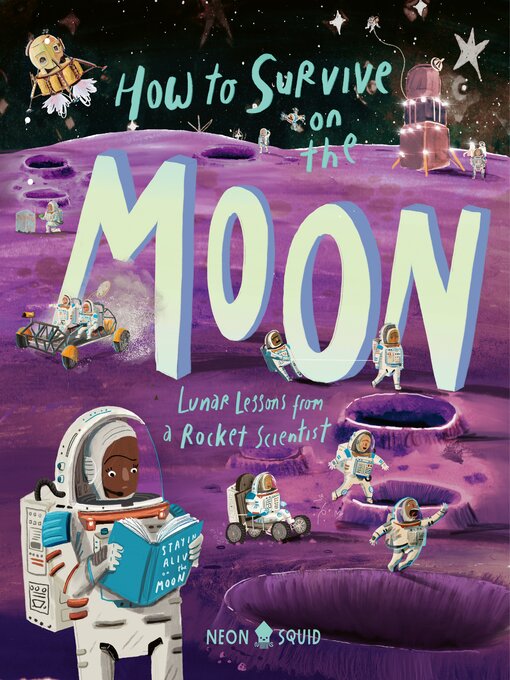An illustrated guide to lunar survival for kids from rocket scientist Joalda Morancy in preparation for the upcoming NASA Artemis moon missions!
Humans are heading back to the moon. But once we get there, how on the moon will we stay alive? In this practical guide, future astronauts will learn how to build underground cities in lava tubes, shield themselves from razor-sharp moon dust, and grow the food they'll need to survive life away from our home planet.
As well as practical tips, Morancy lifts a lid on some of the coolest developments in lunar science—including the possibility of building underground cities in lava tubes and the giant catapult that could be used to get stuff back to Earth.
Like Andy Weir's The Martian everything in this space book is based on real, groundbreaking science. And no one is better placed to write it: when they're not writing kids' books, Joalda Morancy is building the lunar lander the Artemis missions will use to take astronauts—including the first woman and first person of color—to the surface!
Hilarious illustrations by award-winning artist Aaron Cushley, including graphic novel elements, convey the wonder and excitement of future space travel and give this book a key point of difference from other solar system books.
Don't leave Earth without it!
How to Survive on the Moon
Lunar Lessons from a Rocket Scientist
-
Creators
-
Publisher
-
Release date
February 4, 2025 -
Formats
-
Kindle Book
-
OverDrive Read
- ISBN: 9781684495917
-
-
Languages
- English
-
Reviews
-
Kirkus
December 1, 2024
Advice and background for early lunar settlers from a certified rocket scientist. The narrative opens with an illustration of the brown-skinned author reading from a book titledTip-Top Moon Tips. Morancy then invites all "adventurers and cosmic thrill-seekers" to take a near-future flight powered by NASA's Space Launch System to our neighbor the moon. "Surviving an environment that is actively trying to kill you is a challenging feat," the author goes on, but by carefully heeding the book's warnings about hazards ranging from radiation to deadly, insidious dust, new arrivals may live long enough not only to explore the surface, but also to build flourishing colonies in subsurface lava tubes and to gear up for an expedition to Mars. In a utopian vein, Morancy also extrapolates (though not in specifics) the eventual growth of a lunar government, economy, and "the kind of society we wish to see on Earth." Cushley illustrates these visions with detail-crammed scenes of small, racially and culturally diverse figures--starting off with Morancy and a gallery of other contemporary space experts, then going on to depict workers either in vacuum suits or indoor garb engaged in tasks ranging from gardening and governing to shooting Earth-bound cargoes out into orbit using a giant catapult or a futuristic space elevator. A lively mix of facts and informed speculation. (glossary, index)(Informational picture book. 7-9)COPYRIGHT(2024) Kirkus Reviews, ALL RIGHTS RESERVED.
-
Booklist
February 1, 2025
Grades 2-5 Author and real-life aerospace engineer Morancy is also a narrating character in this guide to living on the moon. In thematic double-page spreads, they explore such topics as astronaut training, the moon's geography, and landing on the moon's surface. Amusing, loosely rendered illustrations match the chunked text, made more accessible in the author's chatty style. This book goes beyond others on the topic, as it demonstrates such considerations as how astronauts might live in lava tubes, mine and use the moon's resources, grow food, and create a power grid. Other issues include ethical matters (e.g., moon citizenship and society) and what the future might hold for the moon, such as serving as a training ground for astronauts prepping to visit Mars. In some cases, the double-page spread becomes an infographic in which readers match numbered illustrations to brief descriptions (for instance, "How Not to Die on the Moon" depicts an astronaut turning purple as a visual clue about the lack of atmosphere and breathable air). A fun, creative way to ponder the moon's possibilities.COPYRIGHT(2025) Booklist, ALL RIGHTS RESERVED.
-
subjects
Languages
- English
Loading
Why is availability limited?
×Availability can change throughout the month based on the library's budget. You can still place a hold on the title, and your hold will be automatically filled as soon as the title is available again.
The Kindle Book format for this title is not supported on:
×- - Kindle 1
- - Kindle 2
- - Kindle DX
- - Kindle Keyboard
- - Kindle 4
- - Kindle Touch
- - Kindle 5
- - Kindle Paperwhite
- - Kindle 7
- - Kindle Voyage
Read-along ebook
×The OverDrive Read format of this ebook has professional narration that plays while you read in your browser. Learn more here.


